Note: This website was automatically translated, so some terms or nuances may not be completely accurate.
Kansai Electric Power Preserves the Industrial Heritage of the Kurobe River for Future Generations
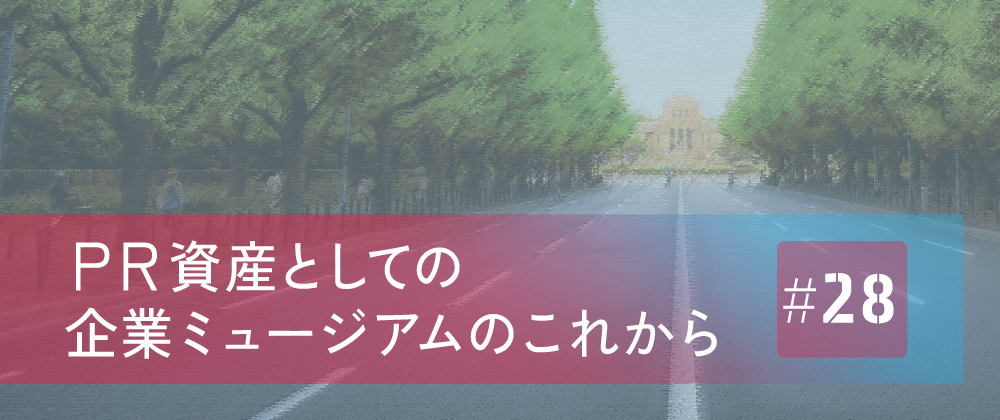
Corporate museums occupy a buffer zone spanning both the academic realm of "museums" and the business realm of "corporations." They are organizations that collaborate extensively with corporate departments such as public relations, branding, advertising, and human resources. In this series, PR professionals will introduce various museums operated by corporations, examining their roles, functions, and potential.
The Kurobe River System Power Generation Facilities in Toyama Prefecture are an industrial heritage site selected by the International Council on Monuments and Sites (ICOMOS) as one of "Japan's 20 20th Century Heritage Sites." Its significance ranks fourth among the 20 sites, following "Ueno Park and its Cultural Facilities," "Yoyogi National Stadium," and "Tateyama Sand Control Facilities." The Kurobe River Electric Power Museum, operated by Kansai Electric Power, conveys this historical and academic value. This article explores the efforts Kansai Electric Power—which has supported the development of the Kinki economy with electricity—is undertaking to pass on the history and significance of these power generation facilities, now gaining attention as industrial heritage of humanity, to future generations.
Reporting and Text: Hiroki Aibara (PR Consulting Dentsu Inc.)
The Kurobe River Electric Power Memorial Museum, operated by Kansai Electric Power. From Kurobe-Unazuki Onsen Station on the Hokuriku Shinkansen, transfer to the Toyama Local Railway at Shin-Kurobe Station. After about 20 minutes, you find yourself surrounded by the mountains of the Northern Alps. As the train gradually climbs along the Kurobe River, it arrives at the terminus, Unazuki Onsen Station. A minute's walk brings you to the starting point of the Kurobe Gorge Railway (Kurobe Gorge Trolley Train). Directly in front of Unazuki Station stands a three-story, mountain lodge-style building. The museum occupies its first floor.
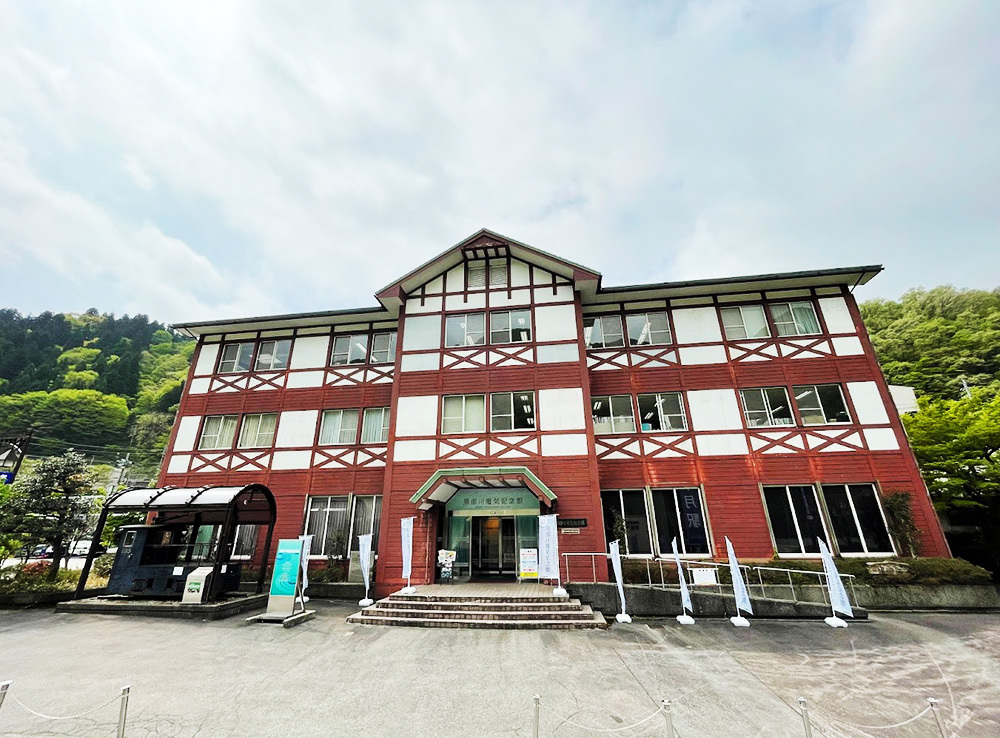
The Kurobe River Electric Power Memorial Hall in Kurobe City, Toyama Prefecture, is a free PR facility opened in 1987. It introduces the history of power development on the Kurobe River, the nature of Kurobe Gorge, and the hydroelectric power plants. It underwent two full renovations in April 1996 and March 2012. Additionally, partial renovations of the exhibition space began in December 2022, leading to its reopening on March 31, 2023.
The facility is overseen by the Public Relations Office at Kansai Electric Power's headquarters in Osaka City, while daily operations are managed by the Hokuriku Branch Office in Toyama Prefecture. The Hokuriku Branch handles event planning, media relations, and various collaborative initiatives with local entities such as the Kurobe Gorge Railway and Unazuki Onsen. Operations for the first-floor Exhibition Room 427, with a total floor area of 1,519 square meters and 14 exhibits, are managed by several local staff members.
In addition to this memorial hall, Kansai Electric Power operates three PR facilities near nuclear power plants in Fukui Prefecture and one near a thermal power plant in Maizuru City, Kyoto Prefecture.
Electric Power Companies in Japan
Until the full liberalization of the retail electricity market in 2016, Japanese electricity providers were categorized as: General Electric Utilities, Wholesale Electricity Suppliers, Wholesale Supply Providers, Specified Scale Electricity Suppliers, and Specified Electricity Suppliers.
General electric utilities are companies that handle everything from power generation to transmission and distribution for general consumers. Japan has ten major companies, and Kansai Electric Power is one of them. It has supplied electricity to Osaka Prefecture (where its headquarters are located), Kyoto Prefecture, Hyogo Prefecture (excluding some areas), Nara Prefecture, Shiga Prefecture, Wakayama Prefecture, and parts of Mie Prefecture, Gifu Prefecture, and Fukui Prefecture.
This time, we welcomed Mr. Yoshihiro Matsumoto and Mr. Yutaka Yoshizaki from the Communication Management Group of Kansai Electric Power's Hokuriku Branch Office to the memorial hall from their office in Toyama City for a detailed discussion.
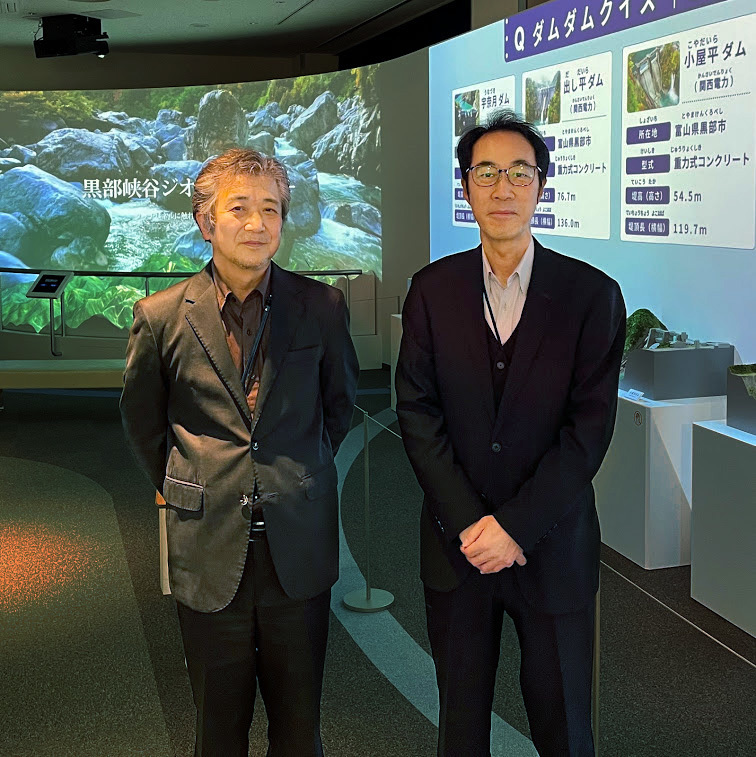
The Hokuriku Branch handles all public relations activities concerning Kansai Electric Power's hydroelectric facilities in the Hokuriku area. They own 38 hydroelectric power plants across four river systems: the Kurobe River, the Jinzū River and Shō River (both in Toyama Prefecture), and the Kuzuryū River in Fukui Prefecture. These plants have a total approved maximum output of approximately 1.92 million kilowatts (about 60% of the company's total conventional hydroelectric capacity) and generate about 7 billion kilowatt-hours annually. Amid growing interest in renewable energy in recent years, hydroelectric power, capable of generating electricity in a very short time, holds an important position as a purely domestic energy source.
The Kurobe River with its 12 power plants
"Why isn't the Kurobe River Electric Power Memorial Museum near the famous Kurobe Dam, known as 'Kuroyon' (Kurobe Dam and Kurobe River Fourth Power Station)?" The author initially had this simple question. Embarrassingly, I had thought the Kurobe Dam itself was the power station. It's important to understand that power development has long been underway not just at Kurobe Dam, but throughout the entire Kurobe River system, with power generation facilities scattered throughout.
The starting point for this power development was Unazuki. Kansai Electric Power owns four dams and twelve hydroelectric power plants on the Kurobe River. Each plant is unmanned, remotely controlled from the Central Hydroelectric Control Center in Osaka City, and the electricity generated is primarily sent to the Kansai region. Incidentally, the largest plant, Kurobe River Fourth Power Plant, is located about 10 kilometers downstream from Kurobe Dam, with all facilities, including the power plant itself, situated underground.

This renovation addresses aging infrastructure approximately 10 years after the previous refurbishment. It also includes updates to some exhibition spaces to allow visitors to enjoy learning about "Zero Carbon." This year also marks a milestone for Kansai Electric Power, as Kuroyon celebrates its 60th anniversary since completion. Furthermore, next year, 2024, coincides with the opening of the Kurobe Route—originally a construction access road—to the public as a travel product, launching as the "Kurobe-Unazuki Canyon Route." Furthermore, Unazuki Hot Springs celebrated its 100th anniversary this year, 2023. The museum hopes that by offering visitors the "Kurobe-Unazuki Canyon Route" and insights into the appeal of hydroelectric power following the renovation, it can contribute to promoting regional tourism.
Learning Hydropower Mechanisms Through Dioramas and Videos
The Kurobe River Electric Power Memorial Hall features two zones: the "Exciting Exploration Zone," where everyone can see, touch, and experience while learning, and the "Knowledge Expansion Zone," which serves a slightly more specialized, library-like function. English, Chinese, and Korean language support is available for foreign visitors. While tourists remain the primary target audience, the museum also serves a significant purpose beyond being a tourist attraction: conveying academic value and the history of Japan's industrial heritage. Consequently, its operations are designed with various stakeholders in mind, including academia, employees of Kansai Electric Power Group companies, and local elementary and junior high schools.
Three new exhibits were added within the "Exciting Exploration Zone": * The "Briefing Station" conveys the museum's exhibits via a large screen. * The "Dam Dam Quiz Theater" allows visitors to learn about hydroelectric power through quizzes. * The "Kurobe Gorge Diorama Theater" introduces the gorge's seasonal nature, the history of power development, and the mechanics of hydroelectric power through dioramas and powerful visuals.

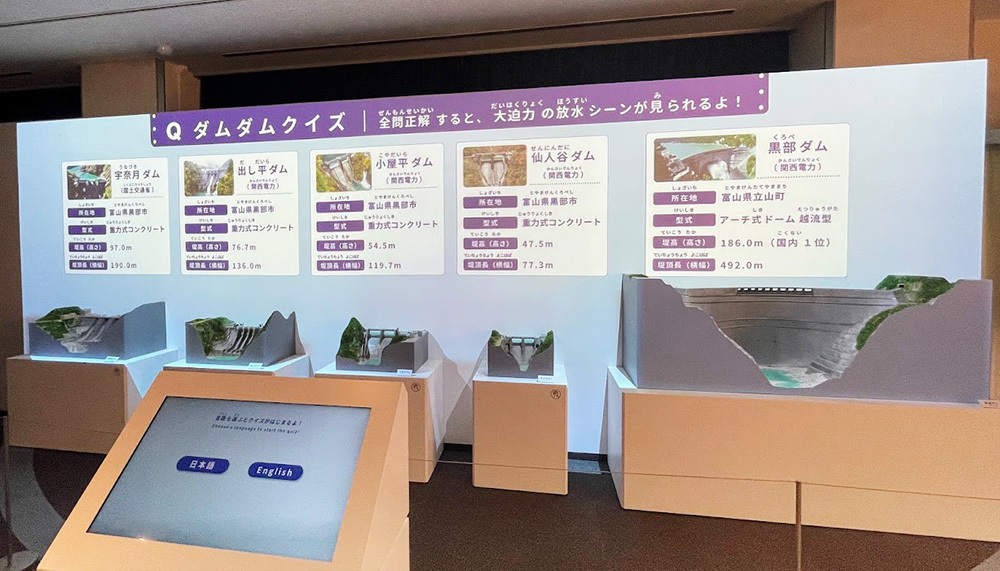
The long-popular "Trolley Train Journey" corner lets you sit in a seat and experience the immersive panoramic visuals created by multi-screen projections, offering the feeling of riding regardless of weather or season. Another section introduces the history of power development on the Kurobe River through rare footage and photos. It realistically explains the construction of the legendary "Kuroyon" (Kurobe Dam and Kurobe River Fourth Power Station), known as the "Project of the Century," using archival footage.
Particularly noteworthy is the Omachi Tunnel (now the Kanden Tunnel) exhibit, considered the most challenging part of the project. Pressing a button plays footage revealing the manual excavation work carried out by people at the time.
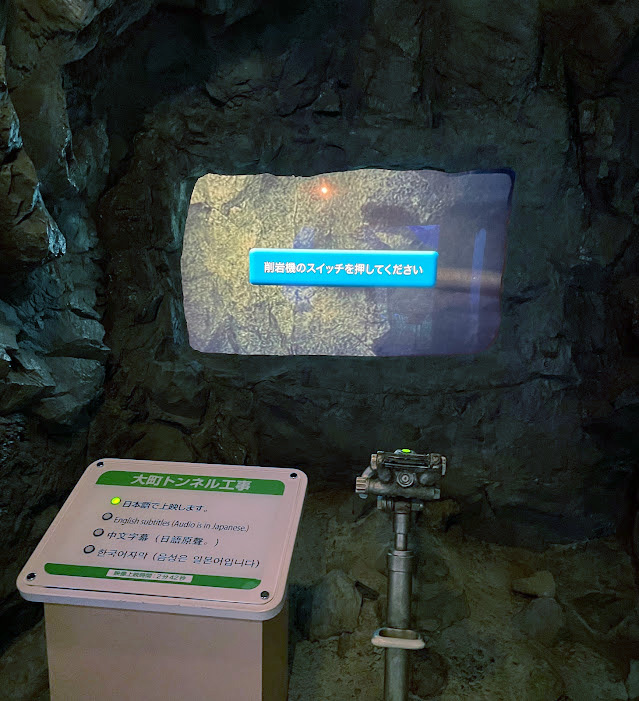
Previous visitors were often people who discovered the facility while sightseeing in Unazuki Onsen or Kurobe Gorge. The trolley train carries 600,000 to 700,000 passengers annually. With the opening of the "Kurobe-Unazuki Canyon Route" next year, even more tourists are expected to visit.
The Kurobe River Electric Power Memorial Museum, which values coexistence with the local community, hopes to leverage its prime location as the gateway to Kurobe Gorge to attract visitors of all ages. On the occasion of the reopening, Ichiro Kume, then President of Kansai Electric Power's Hokuriku Branch, stated, "We hope more people will visit, deepen their understanding of energy, and that this will contribute to promoting regional tourism." To catch the attention of tourists riding the trolley train, a banner was recently installed at the front of the museum.
A merchandise sales corner has also been set up
Next to the information desk, a merchandise corner sells goods related to the trolley train and Kurobe Gorge. The most popular item is the Kurobe Gorge Trolley Train Choro-Q toy car. Other items available include original towels and stationery.

Here is a brief overview of Kurobe Gorge's natural environment, the history of power development, and major facilities like Kurobe Dam.
History of Hydropower Development on the Kurobe River
Hydropower development in the Kurobe River basin began in the Taisho era. The Kurobe Gorge, sandwiched between 3,000-meter-class peaks known as "Japan's Roof," presents a terrain that repels people. However, it is one of Japan's most rain- and snow-heavy regions, featuring steep rivers, making it exceptionally favorable for hydropower generation.
In 1917 (Taisho 6), Dr. Jōkichi Takamine, known for discovering Takamine esterase, was among the first to recognize the potential for hydroelectric power in Kurobe and began investigations. By 1923 (Taisho 12), work commenced on excavating the railway track between Unazuki and Nekomata, and a sun-powered road was also constructed to advance the surveys.
The first power plant in the Kurobe Gorge, Yanagigahara Power Plant, began operations in 1927 (Showa 2), three years after construction started. Trolley trains were used to transport construction materials. By 1937 (Showa 12), the line was extended to Keyakidaira. Tickets from that era, bearing the warning "Safety is not guaranteed," speak to the danger of the trains running along sheer cliffs.
In 1936 (Showa 11), the Aimoto Power Station, located downstream from Unazuki, began operation. Power stations were then constructed further upstream along the Kurobe River, including the Kurobe River Second and Third Power Stations.
Construction of the "Kuroyon" project, hailed as the "Great Project of the Century," commenced in July 1956 (Showa 31). This era saw a rapid surge in electricity demand as post-war economic recovery gained momentum, with the Kansai region facing severe power shortages. Hydropower still dominated over thermal power generation. Kansai Electric Power Company, newly formed through industry restructuring, staked its corporate future on tackling this monumental challenge. Working under harsh natural conditions and utilizing the most advanced technology of the time, construction progressed. In June 1963 (Showa 38), after seven years, a cost of 51.3 billion yen (at the time), and the cumulative labor of 10 million people, it was completed. This significantly improved the power situation in the Kansai region. More specific facts are as follows:
Kurobe Dam: Boasting Japan's tallest dam at 186 meters, a crest length of 492 meters, and a total storage capacity of approximately 200 million cubic meters. The water release conducted from late June to mid-October creates rainbows, adding to its beauty.
Kurobe River Fourth Power Station: Located approximately 10 kilometers downstream from Kurobe Dam. To preserve the national park's landscape and avoid winter snow damage, the entire power station and switchyard are installed underground. It is a dam-type power station with a head of 545.5 meters and boasts a maximum output of 337,000 kilowatts.
Omachi Tunnel (currently managed by Kansai Electric Power): A 5.4-kilometer road tunnel connecting Omachi City, Nagano Prefecture, and Tateyama Town, Toyama Prefecture. During construction, encountering a fractured zone halted excavation, making it one of the most challenging sections of the Kuroyon construction project.
Kurobe Gorge Tram
A leisurely trolley train journey of about 80 minutes one way, running approximately 20 kilometers along the Kurobe River from Unazuki Station (home to the Kurobe River Electric Power Museum) to Keyakidaira Station. It traverses Japan's deepest V-shaped gorge, with an elevation difference of 375 meters. Built by Nippon Electric Power from the Taisho era to the early Showa period, it was taken over by Kansai Electric Power in 1951 (Showa 26). It is currently operated by Kurobe Gorge Railway, now a group company of Kansai Electric Power.

Collaboration with Local Governments
The new "Kurobe-Unazuki Canyon Route," spanning approximately 18 kilometers from Keyakidaira in Japan's deepest V-shaped gorge, Kurobe Gorge, to Kurobe Dam upstream, will open next year in 2024. This route was necessary for Japan Electric Power and Kansai Electric Power to establish as a construction transport route during power development along the Kurobe River.
Kansai Electric Poweris implementing safety measures under the"Agreement on General Access and Tourism Product Development for the Kurobe Route"signed with Toyama Prefecture in 2018. This route offers a rare opportunity to experience both the majestic nature of the remote Kurobe mountains, often called a "hidden realm," and the history of power development that harnessed the collective wisdom of humanity. Travelers who board these extraordinary vehicles, in service since the early Showa period, will be rewarded with a journey full of surprises. This will create a new tourist route connecting the "Kurobe Gorge" with the world-renowned mountain scenery and popular tourist destination, the "Tateyama Kurobe Alpine Route."
Finally...
The Kansai Electric Power Group, as a leading company in zero-carbon energy working toward a sustainable society, has set the goal of achieving net-zero CO₂ emissions from its business activities by 2050 under the slogan "Everyone Take Action: Let's Advance to Zero Carbon!" Within this, the role of hydroelectric power generation—which requires no fossil fuels and emits no CO₂—is critically important.
Life without electricity is unimaginable for modern people. Despite being built over half a century ago, the power generation facilities in the Kurobe River system, boasting top-class generation capacity in Japan, remain active today. While introducing new technologies to improve generation efficiency, we must not forget that relentless inspection and maintenance work is carried out by many people in the harsh natural environment. The Kurobe Gorge Electric Power Museum will continue to tell the story of the history and current state of power development, born from the collective wisdom of humanity, to the many visitors who come to Kurobe Gorge.
[Editor's Note] (From the Web Dentsu Inc. News Editorial Department)
When we think of hydropower, energy, and daily life, the first image that comes to mind is the "waterwheel" of rural villages. Forests cover 67% of Japan's land area. Numerous rivers flow through these forests. Without human intervention, this water—a national treasure—would simply flow out to sea. Sometimes, it causes flooding.
Turn the faucet, and water flows. Toilets, of course, are flush toilets. When you consider how much effort our predecessors must have put in to achieve what we take for granted today, you can't help but feel profound respect.
Hydropower stands as one of the greatest achievements in this regard. It's not the idyllic image of turning a "waterwheel" to grind flour. Generating electricity requires immense-scale construction, equipment, and management. While water itself is a national treasure, we must also protect ecosystems like forests, which are equally precious national assets.
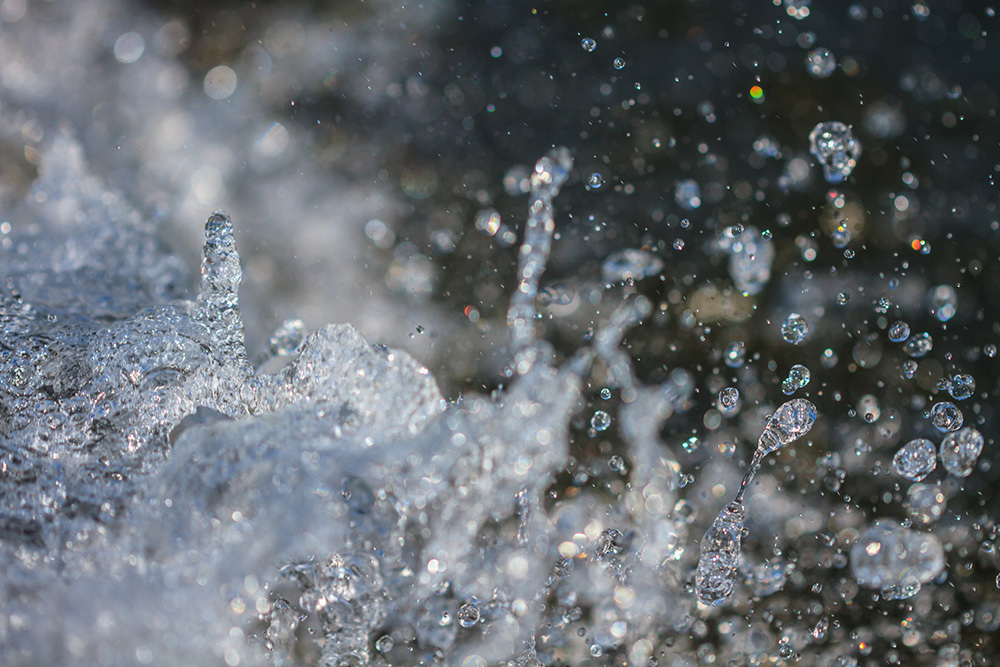
Despite building such an advanced civilization, humanity still cannot control all of nature—water, wind, forests, clouds, the sun. That is precisely why it remains an endless challenge. With the efforts of our predecessors in our hearts, we strive toward a sustainable future.
Was this article helpful?
Newsletter registration is here
We select and publish important news every day
For inquiries about this article
Back Numbers
Author

Hiroki Awaihara
PR Consulting Dentsu Inc.
Kansai Branch Office, Communication Development Department
Kansai Branch Office, Communication Development Department For 38 years, we have been engaged in large-scale projects such as expositions, commercial facilities, and theme parks in the Western Japan region centered on Kansai, as well as regional revitalization. We have provided PR consulting and solutions to over 3,000 B2C, B2B, and foreign-affiliated companies, government agencies, and organizations across sectors including tourism, pharmaceuticals, food and beverages, consumer goods, hotels, machinery, universities, trading companies, sporting goods, and new energy. Additionally, we serve as lecturers for public relations seminars for corporations and local governments.




